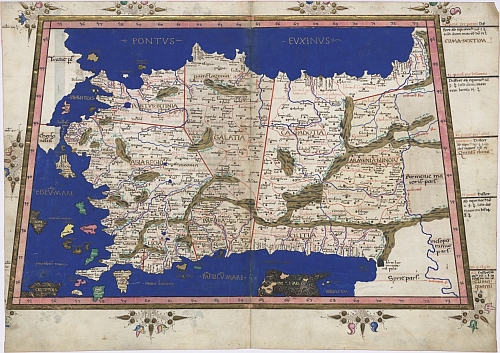




'Alfabeto di Lettere Iniziali' (c. 1730) from designs by Mauro Poggi.
[The edition above, from the Austrian Musuem of Contemporary Art (link below),
dates from c.1750, and the cover page - sans watermark - comes from here]
dates from c.1750, and the cover page - sans watermark - comes from here]
"[T]his lovely engraved oblong folio [is] one of the most delightful 18th century alphabets in the high rococo style. Reflecting the style of the early 18th century engraver, Giambattista Betti, the design of each splendid plate features an elegant cursive capital form of one of the two dozen letters of the 18th century alphabet (there were 24 letters, rather than 26, because i and j were the same letter, and because there was no w).
The capitals are elaborated with scrolls and flourishes and then inhabited by satyrs, mermaids, Medusa heads, birds, cats, dogs, snakes, and other creatures. The letters were designed by Poggi, drawn in ink by Andrea Bimbi, and engraved by Lorenzo Lorenzi. Bonacini characterizes it as a precious collection showing a surprising richness of imagination. Given the work’s obvious esthetic achievement and inclusion in the major bibliographies of writing books, one would expect that Poggi would have produced additional works, but this item is the only one he is known to have done."






'Liber Artificiosus Alphabeti Maioris' (1782-1785)
designs by Johann Merken, engraved by Heinrich Coentgen
designs by Johann Merken, engraved by Heinrich Coentgen
The first and only edition (published in two parts) of this rarely complete calligraphy book included fifty six engraved plates. Besides the elaborate alphabets there are example writing styles, portraits, silhouettes (Lavater purloined one of the plates - not shown - for his 'Physiognomy'), monograms, calendars, fantasy geometrical and architectural figures, emblems, genealogical tables and ornamental letters. I understand (from wonky translations) that the letterpress text included recipes for making different inks.






The only information I can find about the above plates is that they come from a book entitled 'Vorschrift Deutsch-Lateinisch und Franczösischer Schriften Geschrieben' by Johann Jacob Losenawer (Losenawern or Losenauer), published in Stuttgart in 1719 (the above calligraphic flourishes are from a 1739 edition).

Alphabetic ribbon vignette with putto by the prolific
German printmaker/artist, Hans Sebald Beham, 1564.
German printmaker/artist, Hans Sebald Beham, 1564.



The Vatican scriptor, Gianfrancesco Cresci of Milan, heralded the onset of the Baroque by categorically rejecting what he considered were the useless adornments to some of the alphabets produced in the 1540s by the Master calligrapher, Giambattista Palatino*. Palatino responded by adopting letterforms similar to Cresci's (whose first work was published in 1560) only to be accused by Cresci of lacking the necessary skills to produce the set himself, instead hiring an engraver for the work. It was quite the calligraphy/typography scandal of the 16th century. [I believe the modern scholarly consensus, from manuscript comparisons, vindicates Palatino]
The above images are from one of the classic books on letterforms: Cresci's 'Il Perfetto Scrittore', published in 1570. One of the alphabets was the inspiration for the typeface, 'Cresci', designed in 1996.
In passing, I came across the following..
- Luc Devroye's comprehensive history of type (with myriad links)
- The long S (∫) at Typefoundry and Babelstone and the Esszett (ß) at Typefoundry.

Ornamental calligraphy from a suite of prints by Antonello Bertozzi, 1604. I didn't discover any information about the artist, but he did produce a fabulous book on lace patterns, displaying similar styles to the embellishments above, available at Archive.org - I may have to revisit that one in the future.
Unless otherwise noted, all the above images come from the fantastic Ornamental Prints Online site - a collaborative database between The Museum of Decorative Arts in Berlin, The Museum of Decorative Arts in Prague and The Austrian Museum of Contemporary Arts (MAK).
Although there is extensive information in english (top right), the above images (all extensively background cleaned) were generated by searching on 'alphabet' from the search box (top left) at the German interface (>200 results across the institutions). For some reason the same search using the English interface only gives results from one of the museums. In fact, all of the above images are from MAK. The Prague images were prohibitively watermarked in the larger versions and the Berlin images are either digitally watermarked, degrading their quality in the larger jpegs, or are just poor quality files. Nevertheless, this is a wonderful resource site in which to browse.
Thanks very much to Tia for writing to tell of her recent visit to the exhibition in Vienna: 'From Grotesquerie to the Grotesque', which led to the database.
Some of my favourite entries at the now retired Giornale Nuovo were on unusual alphabets/letterforms. See: one, two, three, four, five, six, seven (did I miss any?)










